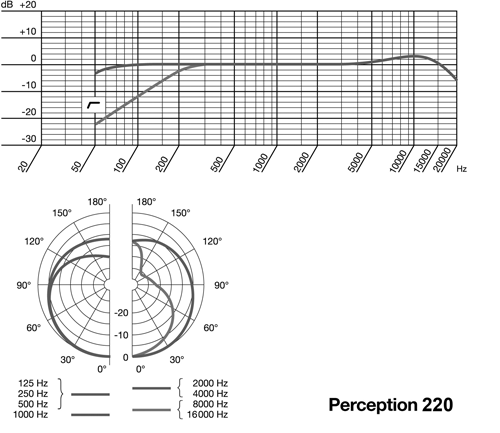THE PERCEPTION 220
Spend a few bucks more and you can step up to the Perception 220. With retail price of $350 and a street price well below $200, you may find it worthwhile. For openers, the side-address 220 has a fixed cardioid capsule with a full one-inch diaphragm. More importantly, its self-noise drops to a respectable 16dB-A, although its output ensitivity drops to 18mV/Pa compared to the 120. The zinc alloy body looks identical to the 120, save that the grill is now nickel-colored instead of blue, and instead of a padded cardboard box you get a real aluminum carrying case. Also included is a proper spider shock mount, an essential addition to any of these microphones.

The frequency plot of the 220 shows that it has the same presence bump around 10 kHz, as does its less expensive sibling. However, that same plot also shows a much extended low-end in the 220, doubtless due to the larger capsule size. The 220 includes the same -20dB pad switch and the same low-cut filter switch (again, 300 Hz, -12dB per octave) as does the 120.
In use, the Perception 220 does sound different than the 120, especially in the low-end and the low mids. This is to be expected, given the larger capsule size. I also noticed a slight difference in the top end, which was slightly smoother and seemed more extended than the 120, although it was equally open sounding. Both of these microphones are solid-state, but I have no way of knowing whether the electronics in them are identical or not so I can’t say what difference they might make.
So what you do you get for your extra $75 to $100? As far as I’m concerned, the biggest bonus is the reduced self-noise. The extended low end is a fine thing, although it is not of great use with most male voice talent. On the other hand, you do get a necessary shock mount and a real big-boy carrying case in which to store the thing.
The build quality of this microphone is above average among Chinese-made microphones at this price point, and it both looks and feels like a substantial, pro piece. Finally, I guess I just like the sound a little bit better -- it seemed less compressed and more natural. It’s still affordable enough to be considered appropriate for a newbie, but it would also serve more experienced talent as a good step up from a dynamic mic.
